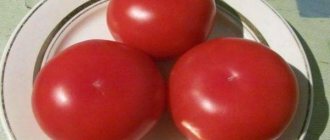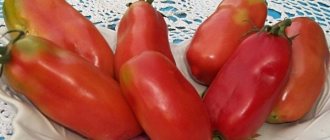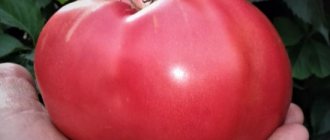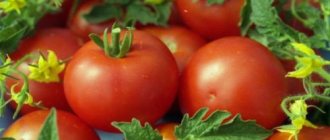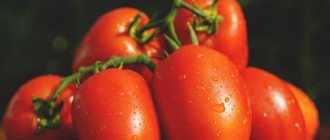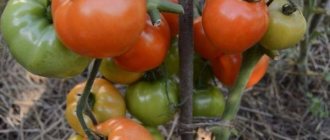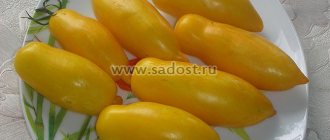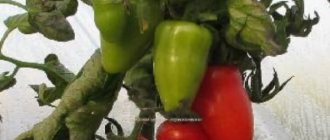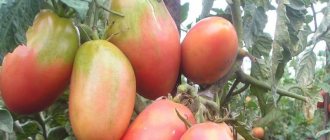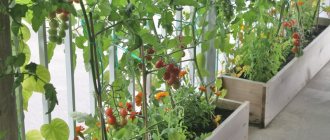Tomato Delicious fully lives up to its name. After all, “Delicious” is translated from English as “very tasty.” Large-fruited tomatoes are unpretentious and become champions in every garden.
| Height | Landing location | Ripening time | Fruit color | Fruit size | Origin | Fruit shape |
| Tall | Greenhouse, Open ground | Mid-season | Reds | Large | Variety | Flat-round |
Description
Belongs to mid-season varieties, from the moment of sprouting to the ripening of tomatoes, 110-120 days pass, and is characterized by high yield. Bushes of medium leafy indeterminate type, unlimited in growth, grow approximately 180-200 cm in height. They can be grown in open ground and in shelters, taking into account the climate of the region.
The fruits are large, from 400 to 600 grams, but you can also grow giant fruits up to 1 kg.
Tomatoes are flat-round in shape; at the stage of technical maturity they are green, when fully ripe they turn bright red. The skin is thin, glossy, the flesh is fleshy, sweet with a rich tomato taste, the seed chambers are small. Interesting! Tomatoes contain many useful substances, such as fiber, pectin, phosphorus, magnesium, sodium and iron, as well as vitamins: A, B, C, E. The
“Delicious” variety is more intended for preparing fresh salads; it is not suitable for canning whole fruits , because the fruits are too big. But it is quite suitable for making juice, paste and sauces. Tomatoes can also be frozen for the winter and added to various dishes. The variety is resistant to many diseases, but can be susceptible to late blight; it is imperative to take preventive measures and treat the plants with preparations such as Metalaxyl and Ecopin. Basil or garlic planted nearby will protect against aphids.
How to protect tomatoes from unpredictable weather
It is difficult to predict in advance what kind of summer it will be - hot, rainy or windy. To increase your chances of getting a decent harvest, you can do the following:
- Plant seedlings grown only from high-quality seeds into the soil.
- The seedlings should have their first true leaves. The bushes should be about 20 cm high.
- Choose a windless, sunny place for planting tomatoes.
- Use well-rotted manure to fertilize the soil before planting seedlings.
- To protect tomatoes from aphids, plant a companion plant next to them - garlic or basil.
- After flowering begins, apply potassium fertilizers every week.
- Watering should be done in small portions, but often. This will protect the tomatoes from cracking.
- Be sure to break off shoots growing between the stems and main branches. The air flow will protect the tomatoes from diseases and help them ripen faster.
A giant Delicious tomato, freshly picked from the bush and grown with one's own hands, is much tastier than one bought in a store.
Growing seedlings
One of the most important conditions for obtaining strong and persistent seedlings is high-quality seed material. Before planting, it must be disinfected and treated with stimulants. Fertile soil also plays an important role; you can buy it or make it yourself. Purchased soil for seedlings is already ready for planting and will not require any additional procedures; a soil mixture made independently must undergo preliminary preparation, it should be sifted to remove debris, larvae or remnants of plant roots, and then disinfected.
Sowing work begins no later than mid-March; the main conditions for growing seedlings are warmth, light and the absence of drafts. Care consists of watering with warm water and fertilizing with liquid complex fertilizers. At the stage of 2-3 true leaves, the seedlings are planted in separate containers. Before planting in the beds, the plants are hardened off for a week.
General description of the variety
Tomato Zhenechka is a variety bred by domestic breeders. It appeared on gardening markets quite a long time ago, but has not yet lost its popularity. The variety is sold in most gardening stores.
Distinctive features of Zhenechka tomatoes
The main feature of the Zhenechka variety is its exceptional endurance. Plants are resistant to cold weather and temperature changes. They are suitable for growing in open ground in the middle zone and northern regions.
This tomato belongs to the ultra-early varieties. Its berries ripen 85-90 days after emergence.
Zhenechka's fruits are not particularly refined. They are medium in size and have the usual tomato sweet and sour taste. Tomatoes are red in color.
The Zhenechka variety is universal in gastronomic terms. It is consumed fresh, canned whole and processed into juices. They are not suitable for freezing and drying.
Tomato is immune to most diseases. Its resistance is lower than that of some modern hybrids. Therefore, he needs additional preventive treatment against diseases.
The peculiarity of the variety lies in the ease of its cultivation. Due to the low growth of the bush, it does not need pinching. Many gardeners don’t even form it.
Main characteristics
The description of the Zhenechka variety will please even experienced gardeners. This tomato is able to grow even in extreme conditions. It was bred for planting in regions with temperate and northern climates.
Characteristics of Zhenechka tomatoes:
| Parameter | Indicators |
| Bush type | Determinate tomato. The height of the bush does not exceed half a meter. The stems are thick and powerful. The bushes are covered with an average amount of greenery. The leaves are medium sized, rich green. The inflorescences are simple. The first is formed after 5-6 leaves. The next ones after 1-2 sheets. The bush is spreading and branched, which is what ensures high yields for dwarf plants. Fruits are formed in clusters of 5 pieces. in each. |
| Growing method | Cold-resistant. Manufacturers recommend growing it in open ground even in regions with cold and temperate climates. Cultivation in greenhouses and on balconies is possible. |
| Productivity | Good for early ripening tomatoes. From one bush you get from 2.5 to 4 kg of berries. For 1 sq. m plant from 6 to 8 bushes. The fruits ripen almost simultaneously. Fruiting continues until August. |
| Fruit | Average. Weight varies from 80 to 100 g. The maximum recorded weight does not exceed 150 g. The fruits are red inside and out. Tomatoes have a round shape, without a flattened base. The berries are fleshy but juicy. The pulp is crumbly. The taste is characteristic of tomatoes – sweet with a slight sourness. One fruit has 4-5 chambers with seeds surrounded by a jelly-like liquid. |
| Transportability | High. The fruits have a tough skin. Thanks to this, they are stored for a long time and are suitable for transportation over long distances. |
| Ripening time | Ultra early ripening. The first harvest ripens 80 days after sowing the seeds. |
| Disease resistance | Is immune to many tomato diseases. There is a risk of fungal infection. |
Transfer
For young tomato seedlings, choose a sunny area, protected from the winds. 3-4 plants are placed per 1 m2. At the time of planting, the seedlings must be at least 65 days old and more than 20 centimeters in height. The soil should be loose, moisture-absorbing and saturated with nutrients; a handful of ash and rotted manure is added to each hole during planting. Since the variety is tall, a garter is required; you should also not forget about removing the stepsons; the bush is formed into 1, 2 and 3 stems. To obtain very large tomatoes, it is recommended to form the plant into 1 stem.
Important! If the bushes do not have enough moisture during the formation of ovaries, they may lose color.
Tomatoes should not be overwatered; 2 times a week is enough. This variety is susceptible to cracking at high humidity levels. You need to fertilize the bushes several times a season, the first time you can use nitrogen-containing fertilizers, after which they should be excluded, otherwise all the plant’s energy will go into the formation of green mass. During the period of fruit formation, it is recommended to use potassium fertilizers; 35-45 grams will be enough per 1 m2. If the leaves on your tomatoes begin to turn yellow, this may indicate a lack of magnesium in the soil. You can help the plant by feeding it with magnesium sulfate; you will need 10 grams of the drug per bucket of water, this amount should be distributed among 3 bushes. Tomatoes growing in a greenhouse must be regularly ventilated; this will protect against fungal diseases that can appear in high humidity.
You should also remove weeds in a timely manner; some gardeners advise mulching the soil, this prevents the growth of weeds and retains moisture. Seeds for the next season can be collected from the harvest; for this, fruits that best correspond to the declared characteristics are selected.
Tomato variety Delicious, video
This is a natural variety of tomato. Therefore, we recommend taking seeds from a ripe fruit and using them for planting in subsequent seasons.
If you have grown Delicious tomatoes, please write how you liked them. What was the yield and taste of the fruit under your conditions? Has this variety become your favorite? Briefly describe the advantages and disadvantages, evaluate the taste. If possible, attach a photo of these tomatoes to your comment. Thank you!
Your reviews of the Delicious tomato and additions to the description will help many tomato lovers evaluate this variety more objectively and decide whether it is worth growing or not.
Growing
It is recommended to start planting seeds to obtain seedlings no later than mid-March. If the air temperature in the room is insufficient, the seedlings can be heated by installing heat lamps.
When the first true leaves appear on the seedlings, diving is carried out. Only strong, healthy seedlings should be selected. You can buy special soil in the store, but it is possible to prepare it yourself by mixing soil from the garden with rotted manure.
It is recommended to plant seedlings of large-fruited varieties in the ground no more than 3 pcs. per 1 sq. m. Plant young plants in a hole with a handful of manure and wood ash. The soil must be thoroughly watered. The next watering is carried out after 7 days.
Sometimes the plant sheds its first flowers. This occurs due to an insufficiently strong root system and the process of adaptation to the new soil. Even if the first flowers do not fall off for some reason, they are advised to be cut off. Fruits grown from such an ovary will not have the necessary condition.
When growing large-fruited tomato varieties, you should not use too much nitrogen-containing fertilizer. In this case, all the plant’s energy is spent on the formation of stems and foliage, while the fruits cease to set and ripen.
It has been noticed that the yield will be higher if the first inflorescence on the bush is removed. After 4 inflorescences form on the stem, its upper part is pinched to prevent further upward growth of the bush. This procedure can be done in mid-August.
1–2 ovaries are left on each inflorescence. Above the last inflorescence, 2 leaves are left on the stem. To prevent large tomato fruits from breaking off fragile stems, be sure to install supports.
Fertilizer
Growing tomatoes must be constantly monitored. If the leaves begin to turn yellow, this may indicate a lack of magnesium in the soil.
This condition in plants is called chlorosis. In this case, the tomatoes are fed with magnesium sulfate: 10 g of the drug per bucket of water. This amount is enough to fertilize 3 bushes. Tomato foliage is sprayed with this solution.
How to water
During the formation of ovaries, tomatoes need more intensive watering. If insufficient moisture is supplied during this period, the plant will usually lose color.
Features of cultivation and care
For seedlings, tomato seeds are sown 60–65 days before planting in the ground. If there is not enough free space between the sprouts, after the formation of 2-3 true leaves, the plants are transplanted into separate containers or dug up. Plants that have formed 5–6 leaves are planted in a permanent place. For 1 sq. m. place 3–4 plants.
In order for the plants to bear as many fruits as possible, crop care should include the following manipulations in the list of care activities:
Watering. Since tomatoes are affected by fungal diseases under prolonged exposure to moisture, water is added to the plants once a week. If the weather is rainy, watering is stopped. Feeding. Fertilize tomatoes of the Yula variety 3–4 times. The first two feedings are applied during the period of active growth. Weak organic solutions or nitrogen-containing mixtures are used as fertilizers. During the period of fruit set and fruiting, plants are pampered with fertilizers with a high content of potassium and phosphorus. Loosening and weeding. To ensure that tomatoes grow quickly and do not get sick, weeds are pulled out as they appear, and the soil is carefully loosened. If these manipulations are not carried out in time, the tomatoes will lack nutrients and sunlight, which in turn will lead to a severe decrease in yield.
Only by following these steps will the Yula variety tomatoes fully comply with all the parameters specified in the description.
Description of the selection tomato Delicious, cultivation and planting rules
The Delicious tomato was bred by US breeders in 1964. There are several varieties of this tomato, all of which bear fairly large fruits. The fruits of this variety taste a little sour. This tomato is used for preparing salads and canning.
Briefly about the Delicious variety
The characteristics and description of the plant are as follows:
- The height of the bush can reach 190-200 cm. Few leaves grow on the stem.
- Tomatoes of this variety have medium ripening periods. From planting seedlings to harvesting takes from 100 to 120 days.
Description of the fruits of the plant:
- Delicious tomatoes have the shape of a flattened ball. Their surface is smooth and glossy.
- Tomatoes are colored red or orange. The pulp of the fruit is fleshy and has a uniform structure.
- Tomatoes on all bushes ripen almost simultaneously.
- The fruit of this variety is gigantic compared to other tomatoes. The average weight of each specimen ranges from 0.4 to 0.6 kg. The tomato is resistant to cracking.
Delicious can be grown in open ground and in greenhouse conditions. This giant does not have time to mature in central Russia, so breeders recommend growing it in film greenhouses. In the conditions of Siberia and the Far North, it is necessary to use greenhouses with good heating. In the southern regions, it is possible to grow this plant in open ground, provided that the seedlings are protected from sudden drops in temperature.
The yield of tomatoes is 6-7 kg per 1 m². Reviews about this variety are positive, as gardeners note the tomato’s resistance to fungal and bacterial infections, despite the presence of other disease-affected plants on the site.
How to grow Delicious?
To get a good harvest, it is recommended to buy seeds in specialized brand stores, since only experienced farmers who obtain seeds from outwardly beautiful specimens that have ripened on the bushes can create a seed fund.
Tomato Delicious red (Delicious red) USA (10 pcs. seeds)
Kentucky Viva USA – tall, mid-early. The fruits are collected in long clusters, 6...
25.00 rub.
18.00 rub.
18.00 rub.
The early variety is a table population. The bush is powerful, semi-spreading, light green in color. ..
15.00 rub.
Mid-early variety. The plant is semi-spreading, well leafy, 40-50 cm high. The leaves are large,...
14.00 rub.
Mid-early (from germination to technical ripeness 105-120 days) variety. Root vegetables are bright orange, horse...
14.00 rub.
14.00 rub.
25.00 rub.
This set presents the best, high-yielding hybrids of cucumbers, which showed excellent...
26.00 rub.
Mid-season variety (period from germination to technical ripeness 110-120 days) with excellent taste qualities..
80.00 rub.
10.00 rub.
New Arrivals
270.00 rub.
20.00 rub.
14.00 rub.
18.00 rub.
This low-growing plant will grow in a short time and give you caps of purple-white inflorescences. Si..
18.00 rub.
Belongs to the group of Pacific hybrids. The plant is tall, 1.8 m high, with large, dense...
26.00 rub.
22.00 rub.
18.00 rub.
28.00 rub.
28.00 rub.
It is distinguished by slender, weakly branching stems, up to 50 cm high. Double flowers, up to 5 cm in diameter.
14.00 rub.
32.00 rub.
15.00 rub.
An openwork, graceful plant, 50 cm high. Stems are highly branched from the base. The flowers are snow-white...
14.00 rub.
A vibrant summer blend of dwarf varieties of annual dahlia. Plants are compact, 35 cm high. Flowers...
16.00 rub.
14.00 rub.
18.00 rub.
Low-growing annual with bright double and semi-double flowers of bright orange color. Forms in..
45.00 rub.
A bright, spectacular mixture of garden carnation varieties, belonging to the grenadine species. Plants with good...
14.00 rub.
15.00 rub.
Tomato Verlioka
photo author Tamara Ovchinnikova
An early-ripening, determinate, medium-sized tomato hybrid for greenhouses and open ground.
Bush 1-1.5 meters high, depending on growing conditions. Plants are tied to a support and led into 1-2 stems. This tomato bush is formed by transferring the growth point to a side shoot (stepchild). How to shape this tomato is clearly shown in the photo.
formation of determinate tomatoes
Basic qualities of fruits
The fruits are round in shape, dense, smooth, red in color at maturity, weighing 80-90 g, good (for a hybrid) taste. These tomatoes are universal in purpose - good for early salads, as well as for canning and processing into tomato products.
Productivity: 9-9.5 kg of fruits per 1 sq.m of plot (subject to agricultural practices).
We recommend sowing the seeds of this tomato for seedlings 60-65 days before the intended planting in a permanent place. Picking at the stage of 2 true leaves. When planting seedlings in the ground for 1 sq. It is recommended to place up to 4 plants per meter of prepared area.
Further care for tomatoes consists of timely watering, weed removal, pinching, fertilizing with complex mineral fertilizer and preventive measures to protect this crop from diseases and pests.
Advantages of the hybrid: resistance to major tomato diseases, stable fruiting, early harvest, tolerance to low light, high taste of the fruit.
We recommend using mulching when growing tomatoes in a greenhouse. Spread hay, straw, or slightly dried grass between the tomato bushes in a layer of 5-7 cm, covering all exposed soil.
This helps retain moisture in the soil and also prevents weeds from growing.
This tomato hybrid was included in the State Register of Breeding Achievements in the Russian Federation in 1990.
Description and characteristics of the variety
Fruit shape: flat-round with slightly pronounced ribbing near the stalk. The color is red. Average yield: 3.8-4.2 kilograms per bush, with a planting rate of 7-8 bushes per square meter.
Tomatoes of the Dachnik variety belong to the determinate type, so their bushes are compact and low (the central shoot reaches 70-75 cm in height), they do not take up much space in the beds, but at the same time they are highly productive.
It is not necessary to tie up the Summer Resident tomato bushes, but it should be taken into account that the shoots may fall to the ground or even break under the weight of ripening fruits.
Important! Due to the compactness and small height of this tomato, the small size of ripe tomatoes and unpretentiousness to growing conditions, many vegetable growers grow the Dachnik variety on a glassed-in balcony or even a windowsill. At the same time, the yield of these tomatoes is not much different from that of tomatoes grown in open ground
The Summer Resident tomato was created specifically for growing in open ground beds and is adapted for normal fruiting even in adverse weather conditions.
The shoots of this variety are medium leafy and dark green in color. The foliage is less than medium in size, typically tomato-like, narrow, and deep emerald in color.
The inflorescences are formed in the internodes, they are racemose, the flowers are small, yellow. Each inflorescence produces up to 10 ovaries.
Ripe fruits of this variety are flat-round and have no ribbing. During the ripening process, the color of the thin, dense skin is soft-salad; as the tomatoes ripen, they become bright scarlet. The tomato pulp is juicy, the number of seed chambers is 4-6 pieces.
Tomatoes are small in size, the weight of one is 75-85 g, the taste of the Dachnik tomato is pleasant, with a characteristic sourness and a typical tomato aroma. The amount of dry matter in ripe fruits is at least 5.5%, sugars - up to 3.2%, vitamin C in 100 g of pulp - at least 17 mg.
Thanks to their dense skin, the fruits are not prone to cracking, tolerate transportation well over any distance, and can also be stored for quite a long time.
The harvested crop has a universal purpose - tomatoes are used fresh, added to salads and snacks, and canned. Ripe tomatoes do not crack during heat treatment, which is a valuable quality when pickling them.
The fruiting of the variety is extended over time, which is convenient for those vegetable growers who do not come to the plot every day; as a result, they harvest from the Dachnik tomato beds in small batches.
Summer resident tomato bushes are resistant to low temperatures - they do not stop growing and bearing fruit in such conditions, which is their undeniable advantage.
The variety from “Sedek” is a determinate, medium-growing variety. The bushes are compact and distinguished by strong, thick shoots. The foliage is moderate. 7-8 fruiting clusters are formed on the bushes, each with 8-10 tomatoes.
Tomato Summer resident F1 is a hybrid that is sometimes confused with the common variety.
Tomato Dachnik differs from “Russian Garden” in the presentation of the fruit. They have a strong skin that does not crack or deform during transportation. The tomato stores well and ripens quickly when harvested unripe.
Ripening dates are early - 95-105 days from germination.
The average weight of the fruit is 100-110 g, they turn red with a beautiful, neat brush.
Summer resident is a cold-resistant and hardy variety. It tolerates temperature fluctuations well and is resistant to sudden cold snaps. According to reviews, even under unfavorable conditions it produces abundant ovaries.
Advantages and disadvantages
Among the undeniable advantages of this variety of tomatoes, the following can be especially noted:
- large fruit;
- excellent taste of ripe tomatoes;
- high productivity;
- resistance to major crop diseases.
The exceptional resistance of seedlings to various diseases can be discussed separately. This tomato is quite hardy; it rarely gets sick even when neighboring tomato bushes are damaged.
Advice. This tomato is disease resistant, but this does not exclude pest attacks. In this situation, you need to act immediately before they have time to destroy the plant. To combat them, use appropriate medications or use effective folk remedies.
The positive aspects of the tomato more than cover some of the disadvantages inherent in the variety, but they still need to be noted:
- Tomato bushes require a certain amount of space in the greenhouse.
- Caring for plants takes longer than determinate tomato varieties require.
- If there is excess moisture, the fruit may crack.
